Why Grow Lights
As a home gardener, one of the most important things to own is a set of good grow lights. Starting seeds can be intimidating if you are new and there are several things that can prevent success. The correct light source is one of those immensely important factors that could mean seedling success or money down the drain. It stands to reason if you are investing money in seeds, then you should invest in lights that will result in great seedlings. This guide is designed to help gardeners understand how light affects plants, which in turn helps us to choose to grow lights that work. There are a lot of details on how light works in this post, but bear with me, it will all make sense once you get to the ‘Things to Remember’ section.
Friendly Warning: There is a lot of nerdy detail on light and measuring light ahead. If you want to really understand the “why”, keep reading. If you want to skip to tips to remember followed by recommendations on specific lights (with some detail on why), click here.
Understanding Plants and Light
Fun fact: Plants cannot use the green light of the spectrum and reflect it back. This is the reason they appear green to us.
Light is tiny particles of electromagnetic energy called photons. Photons travel in mostly straight lines but at different wavelengths. Most of these wavelengths are not visible to humans and are not usable by plants.
The diagram shows the visible spectrum of light that ranges between 400 nanometers and 700 nanometers (400nm-700nm). This is called PAR, or Photosynthetically Active Radiation, and is the wavelength of light that is needed for photosynthesis. PAR is used to measure horticultural light and is not a unit of measure like inches or kilos. Instead, it is a definition of the type of light needed for photosynthesis. Plants use light within the blue and red spectrum, while humans are most sensitive to light within the yellow spectrum. The blue light is needed for strong vegetative growth, the red light for fruiting and flowering. Therefore we are most concerned with the blue light when starting seedlings.
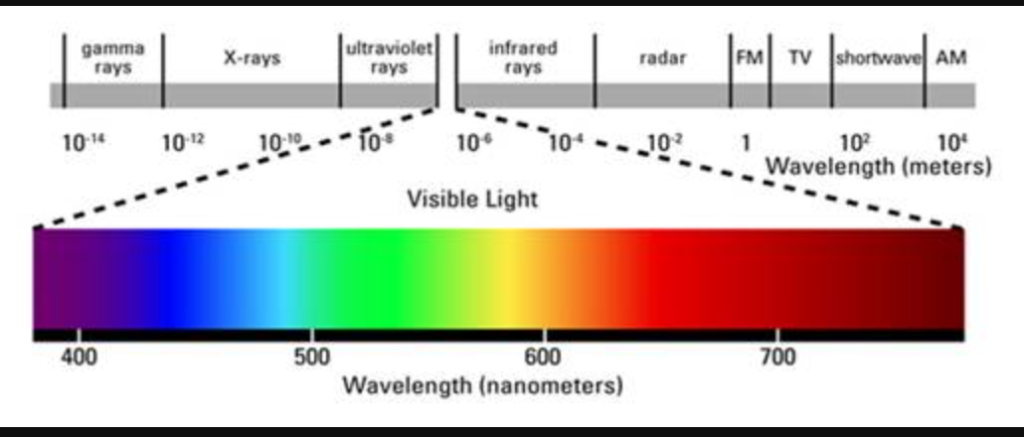
How PAR Is Calculated
We can measure light by counting the number of photons on a surface. For plants, it is important to specifically count the PAR, since this is what affects plant growth. This can be measured by a quantum flux meter, which counts the number of photons on a surface in a second. The unit of measure used to record this information is called micromoles per square, per second (μmol/m2/s). These readings are called Photosynthetic Photon Flux Density or PPFD. Normal daylight can read between 200 to 2000 μmol/m2/s.
Photosynthesis
Plants need PAR light, carbon dioxide, and water to photosynthesize. Photosynthesis is a process where light is used to convert carbon dioxide and water into glucose and oxygen. If one of these factors is out of balance, plant growth will be negatively affected. For example, a lack of light causes leggy seedlings, or a lack of water causes plants to be limp and unable to properly photosynthesize.
Plants require different amounts of light, for example, some plants such as okra require full bright light whereas houseplants (jungle/forest floor plants) require low light in order to properly photosynthesize. Seedlings need 300-600 μmol/m2/s to photosynthesize. Larger plants that are flowering and fruiting need more. However, outside, more than 600 μmol/m2/s is easily available to plants.
How Much Light Do Plants Need?
This brings us to the next really important question: how much light does a plant need each day?
There are two important factors here, distance from the light source and hours of light.
Depending on the light source, plants may receive less PPFD (less intensity of light), but we now know that seedlings need 300-600 μmol/m2/s in order to grow well. Therefore seedlings will need to be closer or further from the lights in order to get this required amount of light. For most types of LED of grow lights, follow the manufacturer’s instructions.
There’s one more term we need to understand here. Day light integral or DLI. So far, we have determined that we can measure the amount of light a plant is receiving per second (μmol/m2/s), but in order to calculate how much light a plant is receiving in a day, we use Day Light Integral (DLI). The unit of measure is micro moles per square meter per day or mol/m2/d. Notice the d instead of s.
300μmol/m2/ over a 12 hour period is equal to 12.96 mol/m2/d. Most plants will require between 12-20 mol/m2/d. Shade loving plants require in the range of 4-10 mol/m2/d.
Should Grow lights be left on for 24 hours?
There have been many studies to determine if it is beneficial to have grow lights on for 24 hours, but studies have been inconclusive. Some plants, depending on the stage of growth benefit from this, others do not. However, in order to receive 12-20 mol/m2/d of light, seedlings should get between 12-16 hours of light.
Can You Grow Seedlings On A Window Ledge?
Many new gardeners try to start seedlings on a window ledge. Unless the window is South-facing and receives many hours of sun, the seedlings are often leggy and weak looking. Thinking about the factors above, most window ledges do not receive enough direct light/light intensity totaling 300-600 μmol/m2/s or enough in a day to total between 12-20 mol/m2/d. Grow lights are a much more reliable option.
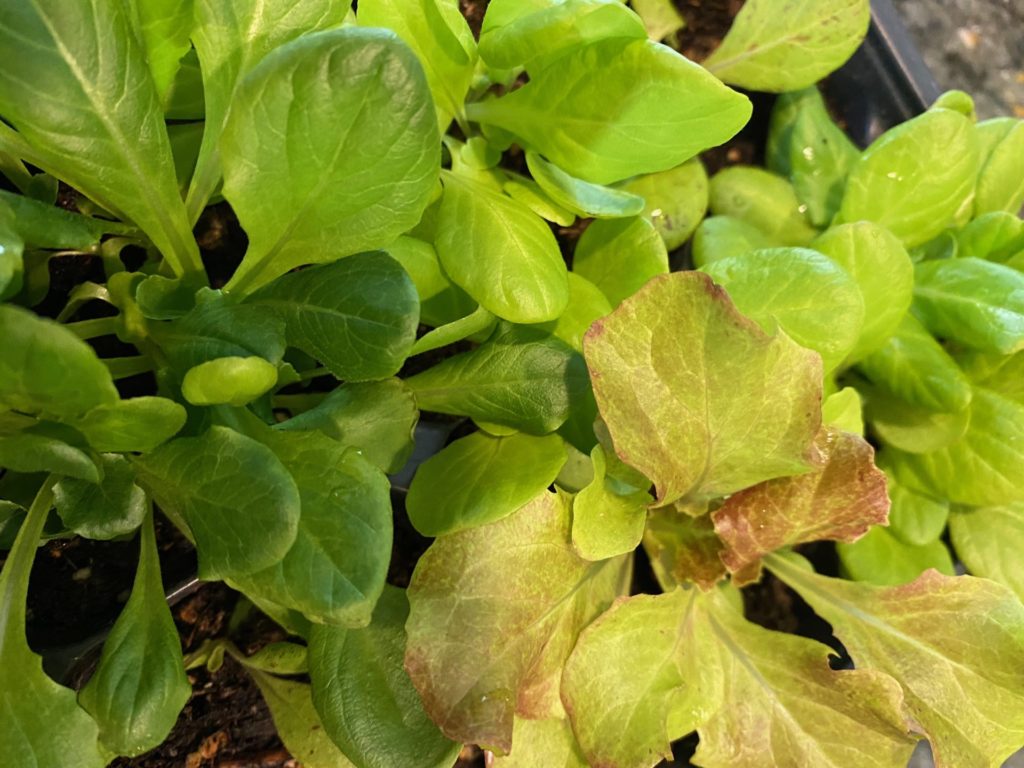
Things To Remember
- PAR light is between 400-700nm.
- When we measure the intensity of PAR light, it is called Photosynthetic Photon Flux Density or PPFD.
- The unit of measure for PPFD is micromoles per square, per second (μmol/m2/s).
- The amount of light received (measured) in a day is called Day Light Integral and is measured in micro moles per square meter per day(mol/m2/d).
Tips for Choosing Grow Lights
- When choosing grow lights look for μmol/m2/s. If your plants are grown inside until they are ready for flowering, the lights will need to be between 300- 600 μmol/m2/s.
- Pay attention to the amount of blue light and red light that the grow lights emit. Remember seedlings will require more blue light. Several models of grow lights now come with a button that switches from vegetative growth to fruiting/flowering.
- Another unit of measure you may see is the color temperature which is measured in Kelvins. Seedlings need at least 65000k, which is more of a cool blue light color temperature. Red light color temperatures range from 1000k- 5000k.
- A lumen reading will be present on the fluorescent tube set up. Lumens measures the amount of yellow light that humans see and it not a good measure to determine lights for plants. However more lumens will generally be better.
- Look for triple chip LEDs. This provides more useable light for plants and is much brighter and efficient than double and single-chip LEDs.
- Look for fans or heat sinks, these keep the light kit cooler. Cooler light kits mean that they will last longer. This may also mean higher wattage, but it is important to keep the lights cool.
- Look for a daisy chain option. Lights that come with a daisy chain option will allow you to attach more than one unit together allowing you to expand your system over time.
- Use an auto timer set up so seedlings can receive between 12-16 hours of light.
- Wattage in LED lights has nothing to do with brightness or how intense the light will be. Wattage relates to the amount of electricity used, and therefore the cost of running the lights.
- Follow the manufacturer’s guidelines for how far away from the plants the light should be from the light source.
- Veg and Bloom Switch options are helpful. All young seedlings including flowers will need to be on the veg switch. Two weeks prior to putting plants outside, also turn on the bloom switch.
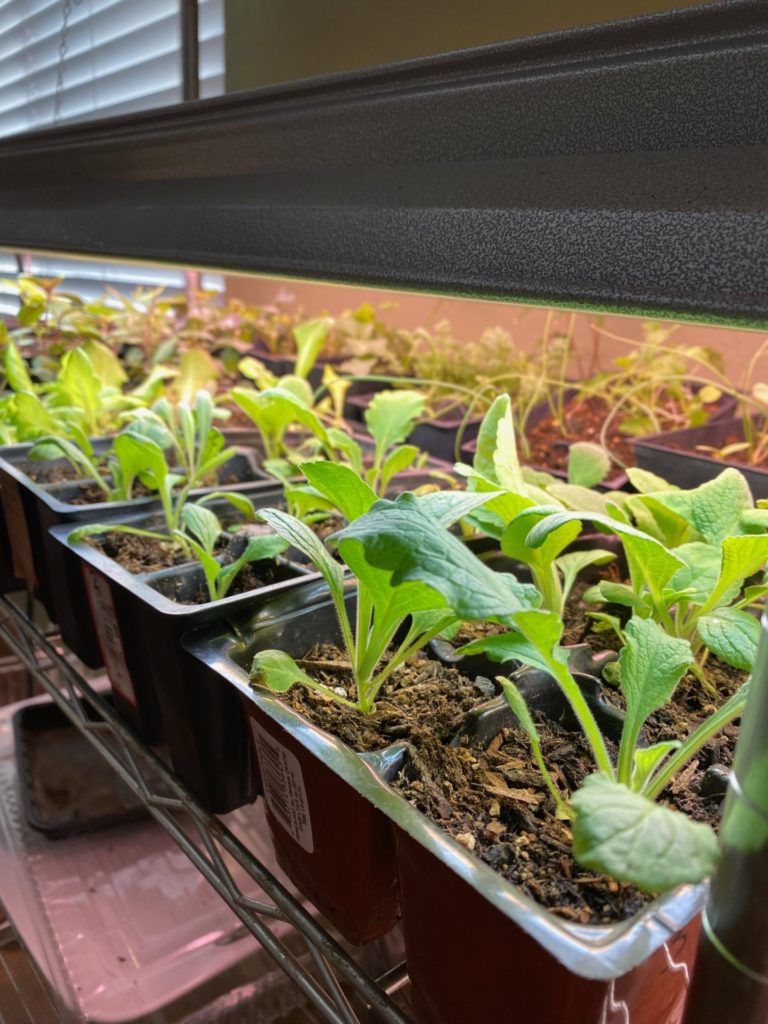
Our Top Picks For Budget Friendly Grow Lights
We looked at budget-friendly picks for the home gardener looking to start seedlings. The information below is based on research and reviews from others. They are in no particular order of preference.
Shop Lights
- The shop light kit is fluorescent lighting that can use T5, T8, T12 ballasts.
- This refers to the diameter of the bulb, but the T12 is the most energy conservative.
- This system is the most budget friendly, costing around $50.
- It is advisable to do a simple LED conversion.
- While this option is the cheapest upfront, it does use more energy than LED grow lights.
- This is the system I have been using since I have started growing my own seedlings.
- It is effective but it does require that the lights be about 3 inches away from the seedlings for effective, non-leggy growth.
- Seedlings will do best if this system is on for 16 hours a day.
- Priced at $119 with free shipping.
- Has a veg and bloom switch to chose from. All seedlings including flowers will need veg. Turn on the bloom cycle as well 2 weeks before setting plants outside.
- Has a daisy chain option.
- Triple Chip LED technology.
- 2 cooling fans and a heat sink keeps the lights cool and quiet.
- At 24 inches high, emits a light intensity of 594 μmol/m2/s.
- Core coverage area is 5.4×5.4ft.
- My personal choice, it offers all the features I am looking for and I will be upgrading to this system.
** Edit** Upon purchasing, I find this system is not quiet as stated by the manufacturer. The fan constantly hums. In addition it is very bright and has to be used with a grow tent or in an area that is not used much. In talking to others, Mars Hydro would have been the better option as it does not have these issues. Overall the product is still great for seedlings.
- Good value at the price point of $94 and free shipping.
- The 1200W PPFD value is 645.7 umol/m²s hanging at 18 inches.
- Thermometer Humidity monitor.
- It is 2 chip LED technology but still offers high PPFD.
- Perfect for a 2x2sq ft growing area at a height of 24 inches. Great for the beginner.
- 3 cooling fans.
- $139.00 and free shipping.
- 3x3ft footprint for vegetative growth stage.
- Efficient heat sink and noise-free fanless design.
- Average 561umol/m²/s at 18” height.
- Very bright light, more white light included.
- While there is no triple chip technology or daisy chain option, this is a very popular model.
- $159 and free shipping.
- Dimmable option.
- Daisy Chain feature.
- 3×3 veg footprint.
- Aluminum heat sink and no fan noise.
- PPFD of 1033 umol/m²/s at 12 inches makes this a great option for further indoor growing.
- Only consumes 100W to get to 1033 umol/m²/s
- The only product with a 5 star rating we found.
DIPINGX Upgraded Full Spectrum 900W
- The cheapest option at $65 and free shipping but still has great features.
- Veg and Bloom Switch.
- Dual chip technology
- 396 umol/m²/s at 24 inches.
- 3x3ft coverage area
- Daisy Chain option to add on later.
- Best option for beginners.
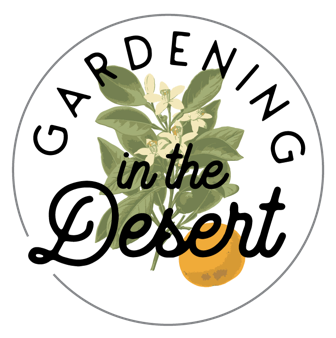
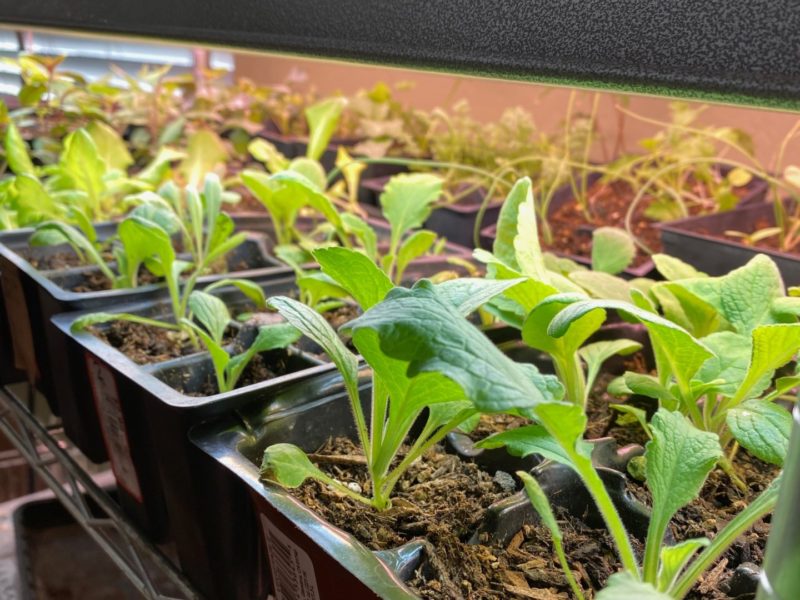
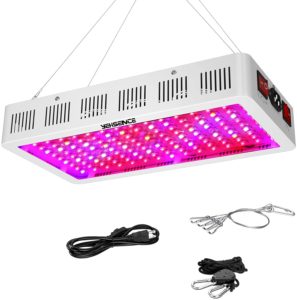
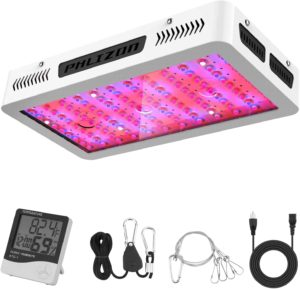
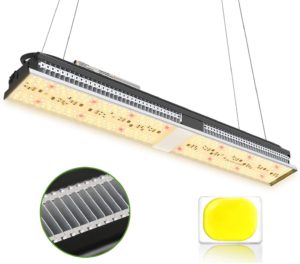
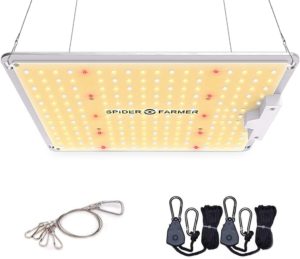
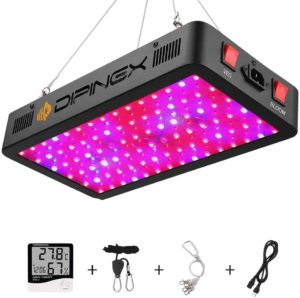
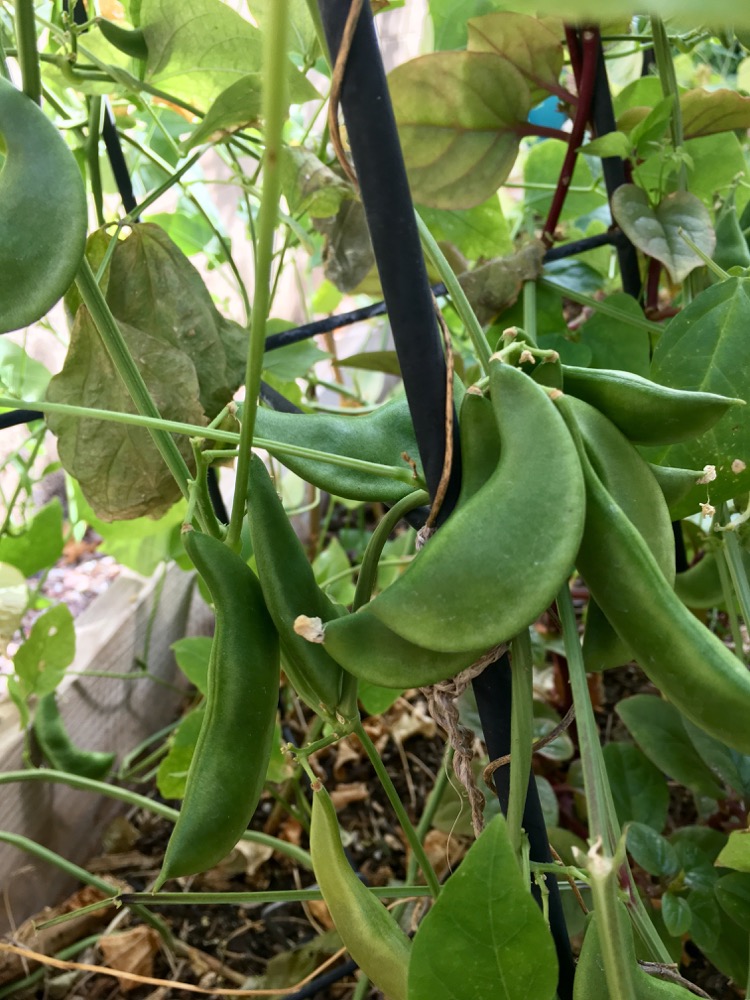
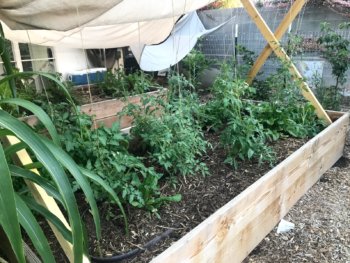
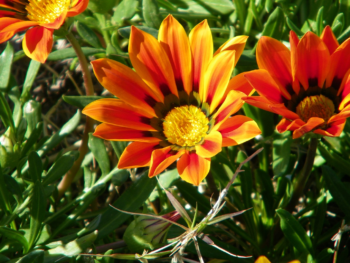
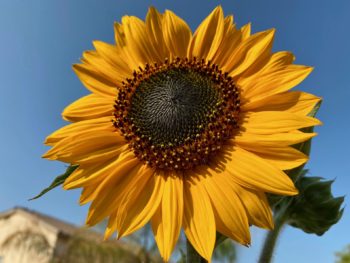
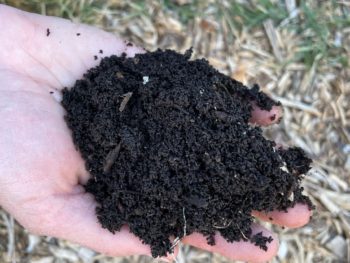
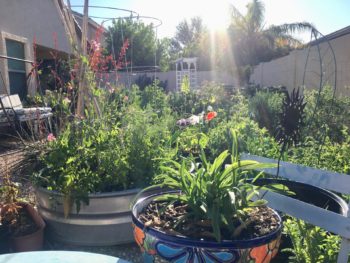
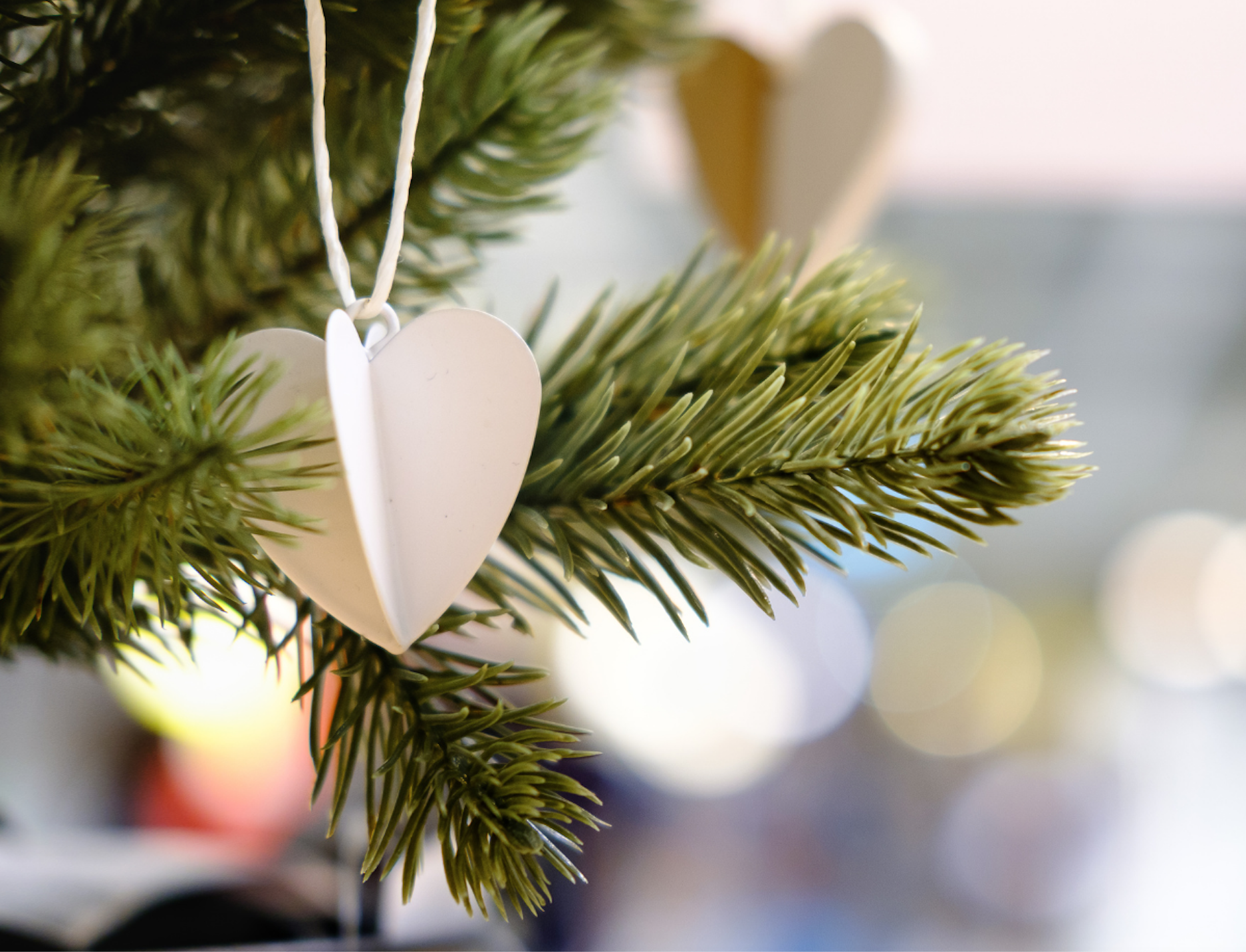
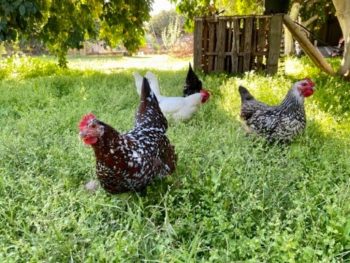
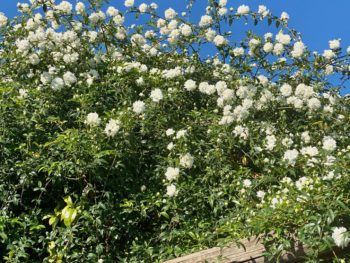
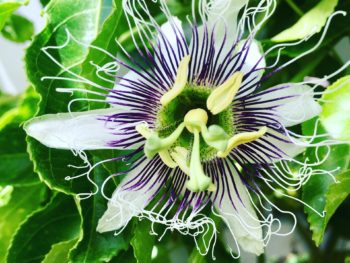
 How to Make Dried Okra Santa Ornaments
How to Make Dried Okra Santa Ornaments
A couple of notes from my own experience:
It’s much easier to use white lights. When you use the pink/purple grow lights, you cannot see the actual color of the plants, and leaves often tell you about the health of the plant. If you use these lights, turn them off every day or two and shine a white light on your plants so you can take a good look at their health. Because you can’t judge the light they are actually receiving, and many manufacturers of lights don’t give enough information on the optimum distance to hang them above the plants, it’s easy to burn the plants with too much light (or hang the light too high and deprive them of enough light). I’ve done both while learning.
The other thing is to get protective glasses. LED grow lights can be damaging to your eyes, and can trigger migraines if light is a trigger for you (it is for me). A good pair of UV-protective safety glasses (they are green) is very helpful and you can actually feel your eyes thank you when you put them on when you are near grow lights. I don’t have a lot of trouble with white fluorescent grow lights, but the pink/purple LED grow lights are actually painful if they shine in my face.